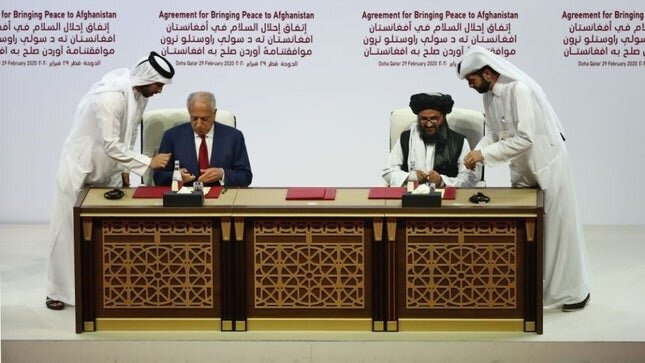U.S.-Taliban pact: Agreement on a new war in Afghanistan

After months of ups and downs, finally, a peace deal was signed between the Taliban and the United States in Doha on February 20, 2020.
It was struck at the presence of representatives of about 30 countries, mostly U.S. allies in the Afghan war. However, no representatives from the Afghan government were present at the signing ceremony.
At the time of the signing ceremony, NATO Secretary-General Jens Stoltenberg and U.S. Secretary of Defense Mark Esper also traveled to Kabul and met Mohammad Ashraf Ghani and Dr. Abdullah Abdullah, both claiming victory in the recent presidential election. They released a statement reaffirming their commitment to the Afghan government.
The Afghan authorities, who considered the agreement as a step towards peace in the country, couldn't ignore the numerous ambiguities and shortcomings surrounding the agreement.
Several fundamental issues have now come to the attention of Afghan experts and politicians regarding the agreement.
First, the United States has given concessions to the Taliban that are not essentially within Washington’s authority. 5,000 Taliban prisoners are in the custody of the Afghan government, and the United States, as a foreign country, has no right to make decisions about them.
In his first speech since signing the agreement, Ashraf Ghani stressed that the release of Taliban prisoners was not part of the U.S. authority.
Second, the U.S., while claiming not to recognize the Taliban as a government, explicitly and implicitly disparages the current Afghan establishment and recognizes the Taliban as a government. The peace document underscores the U.S. government's cooperation with the Islamic state which will be formed following an agreement in the wake of inter-Afghan talks. This part of the agreement means that there have been conversations behind the scene between the two sides regarding restructuring the system and unwritten agreements.
The United States has also called on the Taliban not to issue passports, visas or other ID cards to those who have enmity toward the U.S. These are all within the authority of a government, not groups.
Third, since the inter-Afghani talks which is supposed to start these days, there is no specific issue on the agenda and it is not even clear who is going to be a negotiator on behalf of the Taliban.
The Taliban continue to insist that they do not recognize the Afghan government and will not talk to its officials. The Afghan government also insists that the members of the negotiating team must be determined by the government.
Experts believe that these ambiguities are deliberately aimed at shaping Afghanistan's political space for the coming days.
Fourth, the agreement was signed at the presence of representatives from 30 countries and the UN. However, neither the Afghan government nor the representatives of civil and political groups were invited to the ceremony.
Experts are asking why no Afghan government delegate was invited to the event. They have likened the signing of the agreement to the “Deal of the Century”.
Fifth, hours after the signing of the agreement, U.S. President Donald Trump told a news conference that the Taliban would fight the terrorists, which means that the deal is not for peace, but a new way of managing the war in Afghanistan and that the Taliban is not going to give up fighting.
The U.S. definition of "terrorist" has always been changing rapidly. And now with Trump's definition, Taliban is a U.S. ally and that makes it unclear whom will they fight as a terrorist? This ambiguity makes the future of the war in Afghanistan extremely worrying.
Source: Tehran Times
